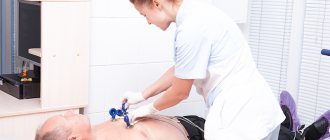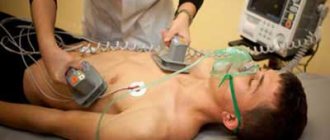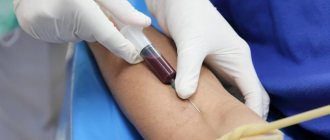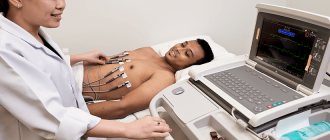The effect of gravity when changing body position forces the circulatory system to work differently. In a split second, up to 800 ml of blood flows into the lower extremities, and venous return to the heart, cardiac output and blood filling of the cardiac cavities decrease. If the cardiovascular system is not functioning properly, a sudden change in body position can cause severe dizziness, sudden jumps in blood pressure, and fainting. In such cases, the patient may be recommended to undergo a test such as an orthostatic test .
Indications for orthostatic test
The main objectives of the orthostatic test are to determine the relationship between observed symptoms and suspected diseases, clarify the diagnosis of latent hypertension, and help the doctor in selecting the dosage of certain medications. However, an orthostatic test is prescribed for diagnosis:
- coronary insufficiency;
- arterial hypertension;
- orthostatic hypotension;
- orthostatic tachycardia;
- dysfunction of the autonomic nervous system.
Also, samples of this type are necessary to monitor the patient’s condition during treatment with certain medications that cause circulatory disorders. Among such drugs are methyldopa, ganglion blockers, sympatholytics.
Carrying out an orthostatic test
Modern medicine practices two types of orthostatic test
- A passive test is carried out with the patient on a special rotary table, eliminating the need to apply muscle force.
- An active orthostatic test involves the patient independently changing the position of his body. In both cases, the patient is connected to a series of sensors that continuously monitor vital physical parameters.
Active orthostatic test
This technique is the most common. During the examination, the patient takes a place on the orthostatic table and is connected to an automatic blood pressure measuring device. During the first 15 minutes, the patient's initial pressure and pulse are recorded at short time intervals in a horizontal body position. Then the patient is asked to take a vertical position for 10 minutes and again a horizontal position. Pulse rate and blood pressure levels are recorded continuously every 1 to 3 minutes. In the absence of deviations, the patient does not experience any discomfort, and the heart rate and pressure do not increase compared to the recorded initial values by more than 20 beats per minute and 10 mm. rt. Art..
Passive orthostatic test
In addition to the principle of changing body position, a passive orthostatic test differs from an active one in that in this case it is possible to supplement the examination with indicators of the electrical activity of the heart using ECG sensors and blood supply to individual organs using plethysmography. The expanded capabilities of this type of test greatly increase the efficiency of the examination, as they allow the most minimal deviations to be accurately determined.
Sometimes, to assess the response of the cardiovascular system to changes in body position, in addition to these methods, pharmacological research methods are used. In this case, the orthostatic test is performed twice - before and after the use of medications.
LONG-TERM PASSIVE ORTHOSTATIC TEST (TILT TEST) TO DETERMINE THE CAUSE OF SYNCOPAL CONDITIONS
The long-term passive orthostatic test (Tilt-test) has been performed in the Department of New Diagnostic Methods since 1991.
A long-term passive orthostatic test (LPOT) is performed on patients suffering from repeated bouts of loss of consciousness (fainting). Syncope (fainting) can be caused by diseases of the cardiovascular or nervous system, but can also be observed in the absence of any pathological manifestations in these systems. Among the many types of syncope, one can distinguish the so-called neurocardiogenic syncope . This term characterizes a group of clinical syndromes manifested by attacks of loss of consciousness and associated with the pathological reflex effect of the autonomic nervous system on the regulation of vascular tone and heart rate. This group also includes vasovagal fainting, which is a fairly common variant of short-term loss of consciousness and, according to various authors and in various categories of patients, accounts for from 28 to 93% of the total number of syncope.
Indications for performing a long-term passive orthostatic test are:
- clarification of the genesis of recurrent syncope and presyncope attacks of unknown cause;
- monitoring the effectiveness of therapy or an implanted artificial pacemaker (pacemaker) in patients with previously observed syncope.
If an examination carried out within the walls of the Institute of Cardiology, which included: a clinical examination, ECG, echocardiography, transesophageal and/or intracardiac electrophysiological study (to exclude the arrhythmic nature of fainting), a test with massage of the areas of the sinocarotid zones (to exclude carotid sinus syndrome), electroencephalography with provocative tests, examination by a neurologist, the cause of syncope has not been determined, the patient undergoes DPOP with continuous non-invasive (bloodless) monitoring of blood circulation parameters in mandatory combination with electroencephalography (EEG).
Contraindications for this study are:
- unstable angina;
- circulatory failure, starting from class II according to NYHA classification;
- severe arterial hypertension;
- condition after acute cerebrovascular accident (less than 6 months);
- severe respiratory failure;
- acute thrombophlebitis;
- acute infectious diseases;
- endocrine diseases;
- mental disorders;
The test is carried out in the morning (from 10 to 12 o'clock), on an empty stomach and against the background of withdrawal of all cardioactive and psychotropic drugs, for at least 5 half-lives.
The patient is introduced in advance to the research methodology in order to exclude pronounced manifestations of anxiety, an explanatory interview is conducted, following which the patient is asked to read and sign the “protocol of informed consent of the patient for a long-term passive orthostatic test”, developed in the Department of Clinical Electrophysiology of the Research Institute of Cardiology named after. A.L. Myasnikov RKNPK and accepted by the ethics committee of the Institute in 2000.
DPOP is performed on a special rotating (orthostatic) table, which allows the patient to be transferred from a horizontal to a vertical position and back with an adjustable angle of inclination. The table is equipped with a foot rest, a footrest to facilitate climbing onto the table and seat belts.
During the test, the following biosignals are recorded:
- ECG in standard lead II;
- Tetrapolar thoracic rheography according to Kubizek and its first derivative (differential rheogram), necessary for documenting changes in blood flow and blood supply, as indicators of “disturbing” effects on the patient’s circulatory system;
- Rheovasography of the left leg, for an objective assessment of vascular tone and blood deposition in the lower extremities;
- The signal from the chest breathing sensor to assess the frequency and depth of breathing in order to take into account the factor of hyperventilation at the time of development of presyncope and syncope;
- EEG in four bipolar leads allows you to document possible epileptiform manifestations.
For operational monitoring of blood circulation parameters during a long-term passive orthostatic test, either a computerized rheograph-polyanalyzer RGPA-6/12 with REAN-POLY software of domestic production (MEDIKOM-MTD, Taganrog) or a similar Task Force Monitor complex is used , (manufactured by CNSystem, Austria).
After applying the necessary electrodes and sensors, the patient is placed on an orthostatic table and secured with seat belts.
Initially, for at least 20 minutes, with the patient in a horizontal position, measurements and registration of background (initial) values of circulatory system indicators are carried out for operational monitoring. Then the patient is transferred to a vertical position (+ 60°) with the legs resting on the stand of the orthostatic table. In this position of the patient, the main indicators of the state of the cardiovascular system (Heart Rate, Stroke Volume, Minute Volume of Blood Circulation, Total Peripheral Vascular Resistance, Blood Pressure) were continuously monitored in real time in automatic mode for 40 minutes, or before the development of syncope.
The criteria for stopping the test (turning it into a horizontal position) are:
- development of syncope or presyncope, in which case the test result is considered positive;
- achieving the specified duration of the study.
If during DPOP it is not possible to induce a syncope (presyncope) state, the test result is considered negative.
After transferring the patient to a horizontal position, recording and monitoring of hemodynamic parameters continues for 5–10 minutes until they are completely restored.
After completion of the DPOP, the patient is given a conclusion and study protocols
LONG-TERM PASSIVE ORTHOSTATIC TEST (TILT-TEST) WITH ASSESSMENT OF FLUID REDISTRIBUTION IN DIFFERENT REGIONS OF THE BODY
In the Department of New Diagnostic Methods of the A.L. Myasnikov Research Institute of Cardiology, RKNPK, a version of a long-term passive orthostatic test (LPOT) has been developed and used to diagnose possible regions of blood deposition in patients with syncope. This test is performed to select tactics for further treatment of patients using therapeutic knitwear. The test is carried out according to a protocol developed at the Institute of Cardiology. Monitoring of the redistribution of blood volumes is carried out using the device “Analyzer for assessing the balance of water sectors of the body ABC-01 MEDASS” with ABC-501 software for assessing the redistribution of venous blood in orthostatic, pharmacological and other stress tests, developed and produced by JSC STC “MEDASS” ( Moscow city). If the DPOP result is positive (the development of syncope or presyncope during the test), the region of the patient’s body in which the maximum deposition occurred is determined.
Literature. 1. Gekht B.M., Petrenko B.E. Mechanisms of vasovagal syncope in patients with different characteristics of transient processes of the cardiovascular system. Cytolysins. In the book. “Neurology of fainting and hypoxic states of the brain” (proceedings of the 2nd Moscow Medical Institute). Ed. Erokhina L.G. – M, -1977, vol. 76, issue 6, pp. 47-58. 2. Gukov A.O., Zhdanov A.M. Carotid sinus syndrome and vasovagal syncope. II scientific and practical conference “Clinical and physiological aspects of orthostatic disorders”. Moscow, March 22, 2000, pp. 46 – 62. (www.medass.ru) 3. Erokhina L.G. Clinic and treatment of syncope in some forms of cerebral and somatic pathology. Guidelines. M. RGMU 1993. 4. Pevzner A.V., Kuchinskaya E.A., Vershuta E.V., Albitskaya K.V., Kheimets G.I., Tripoten M.I., Moiseeva N.M., Rogoza A.N., Golitsyn S.P. Possibilities of long-term orthostatic and bicycle ergometer tests in the differential diagnosis of syncope of unknown origin. Therapeutic archive No. 11, 2004, pp. 23 -27
5. Rogoza A.N., Kheimets G.I., Pevzner A.V., Pantaeva N.M., Ponomarev Yu.A., Tsegelnikova A.L., Skomorokhov A.A., Kalinichenko N.N., Noskin L.A., Chashchin A.V., Pivovarov V.V. The key factors of instability of the circulatory system during orthostatic tests are the possibilities of objective analysis. II Scientific and Practical Conference “Clinical and physiological aspects of orthostatic disorders”, Moscow, March 22, 2000, pp. 102 – 122. (www.medass.ru)
6. Rogoza A.N., Pevzner A.V., Tripoten M.I., Kheimets G.I., Skomorokhov A.A., Vershuta E.V., Kuchinskaya E.A., Atkov O.Yu. Long-term passive orthotest for neurocardiogenic syncope. IV Scientific and Practical Conference “Diagnostics and Treatment of Cardiovascular System Regulation Disorders”, Moscow, March 20, 2002, pp. 262 – 281. (www.medass.ru).









